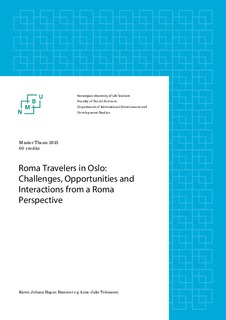| dc.description.abstract | Roma, the largest minority in Europe, continue to face poverty and segregation in their host countries. As a result, Norway amongst other Western European countries, has witnessed a large influx of Roma travelers over the past years. Roma migrate to Norway in search for better opportunities and stay for short periods at a time. The increasing visibility of Roma in the streets of Oslo has sparked a lot of public debate often portraying them as a problem and a challenge to the welfare state. This study has been carried out to examine the historical, social, economic and cultural forces behind Roma traveler’s migration and livelihoods in Oslo. The study aims to understand Roma experiences of migration through a social-constructivist approach, by looking at society and challenges through the lens of Roma’s interpretations. Over the past years, Norway has implemented various political strategies to limit Roma migration and their scope of maneuver. However, although Roma experience constraining environments Roma often seek opportunities where others see closed doors and find tactical ways to survive. In light of these structural constraints and opportunities Roma face, this study uses the structuration theory to explain the interplay between Roma and their environment. More specifically, this study uses the theory of culture and agency to explain the outcomes and challenges that arise when Roma culture meets the host culture. Also, the concepts of tactics and strategies are used to explain what Roma resort to do and what they are able to do within Norwegian society. Moreover, within the intersection between Roma culture and the host culture, this study aims to explore the scope for Roma to practice their own culture within the human rights framework.
This study shows that the issue of Roma migration and livelihoods in Norway does not take place in a social and political vacuum; rather there are structural forces that enable and constrain Roma through this process. We argue that changes are slowly taking place in the practice of Roma culture, changes that are setting up a new conditioning structure with new possibilities for Roma maneuver. | nb_NO |

